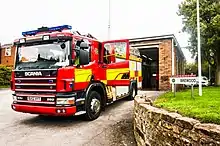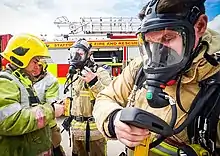Staffordshire Fire and Rescue Service
Staffordshire Fire and Rescue Service is the statutory fire and rescue service responsible for fire protection, prevention, intervention and emergency rescue in the county of Staffordshire and unitary authority of Stoke-on-Trent. The county has a population of 1,126,200 (mid-2017 estimate) and covers a total area of 2,260 km2 (870 square miles). Staffordshire shares the majority of its border with Derbyshire, Cheshire, West Midlands (County) and Shropshire; although, in much shorter stretches, the county also butts up against Worcestershire, Warwickshire and Leicestershire.
The Service's badge features a Stafford knot | |
| Operational area | |
|---|---|
| Country | England |
| County | Staffordshire |
| Agency overview | |
| Established | 1974 |
| Chief Fire Officer | Rebecca Bryant QFSM |
| Facilities and equipment | |
| Stations | 33 |
| Engines | 39 |
| Trucks | 2 |
| Rescues | 1 |
| Rescue boats | 2 |
| Website | |
| www | |
As of 1 August 2018, the fire service functions under the control of the Staffordshire Police and Crime Commissioner[1] acting as the Fire & Rescue Authority.
The county provides considerable risks to its residents and firefighters. These include the industrial city of Stoke-on-Trent and the large industrial towns of Burton-upon-Trent, Stafford, Newcastle-under-Lyme, Tamworth and Cannock.
The M6 motorway runs through the county, as does the M6 Toll road. The main 'A‘ roads the A5, A50, A34 and A38 also cross the county. These well-used routes are regularly the scene of numerous road traffic accidents, vehicle fires and chemical incidents.
There are also many significant rural risks in Staffordshire: The medieval hunting grounds of Cannock Chase is designated as an Area of Outstanding Natural Beauty (AONB), and is made up of heathland, chaseland and forest that stretches between Stafford, Cannock, Rugeley and Chase Terrace. In the north of the county the Staffordshire Moorlands is an area of remote wilderness where The Pennines spill over the Derbyshire and Cheshire borders, and has an area of around 576 km2 (222 square miles). These areas pose a considerable risk of wildfires, and regularly keep firefighters extremely busy during hot dry spells. Also, the moorlands offer their own logistical difficulties during harsh winters, particularly to the residents of the towns and villages dotted throughout the hills - towns like Leek and Biddulph, and the villages of Ipstones and Longnor amongst others. The Staffordshire Moorlands is home to the village of Flash, at 463 m (1,519 feet) above sea level.
Organisation

The service is run under the command of the Chief Fire Officer and an executive board, and provides emergency response from 33 strategically located fire stations, divided into three delivery groups:
- Northern
- Eastern
- Western
Staffordshire Fire & Rescue Service has its headquarters and training school at Pirehill near the town of Stone in mid-Staffordshire. Their fire control centre used to be at Pirehill, but was closed after its amalgamation with fire control of the West Midlands Fire Service in March 2014. So now both brigades operate under a joint control centre situated in Birmingham. The county's maintenance workshops are located at the Joint Emergency Transport Facility in Trentham Lakes industrial park, a Joint Workshop with Staffordshire Police and Staffordshire Fire and Rescue Service.

Of the thirty-three strategically located fire stations, only Stafford, Tamworth Belgrave and Sandyford operate on a completely wholetime (W/T) 24-hour crewing basis.
Longton, Hanley, Newcastle-under-Lyme, Cannock and Burton-upon-Trent operate as wholetime/retained stations (WT/RET), which means, along with a 24-hour station-based complement of firefighters, they have retained on-call "back-up" personnel that, when required, crew the second fire engine housed at the fire station, as well as some of the specialist appliances stationed there. All wholetime firefighters work the four "watch" system. This produces an eight-day week, with crews operating on a "two-days-on, two-nights-on, four-days-off" system. The eight-day week means that a firefighter's duty shifts and their days off "rotate" by one day week-to-week.
Leek and Lichfield fire stations are day-crewed/retained (DC/RET): firefighters respond from the fire station as wholetime firefighters between the hours of 8:00 am and 6:00 pm with a retained on-call crew available if needed to crew other appliances based at the station. After 6:00pm the stations become retained on-call only, and the fire appliances are crewed by the same firefighters but not from the station itself.
All other Staffordshire fire stations are retained on-call only (RET). All retained firefighters respond from home or work, and are notified by a pager, and, therefore, have to live or work within five minutes driving time of their station to meet strict Home Office response times.
Fire stations/appliances
| Station Callsign | Station Name | Duty System | Appliances |
|---|---|---|---|
| T11 | Leek | DC/RET | PRL, PRL/ARU, L4V |
| T12 | Longnor | RET | PRL(4x4) |
| T13 | Biddulph | RET | PRL |
| T14 | Ipstones | RET | PRL(4x4) |
| T15 | Cheadle | RET | PRL, F/WC |
| T21 | Newcastle-under-Lyme | WT/RET/CC* | 1x PHRT, 1x PRT, WRU*, WFU*, IRU* |
| T22 | Kidsgrove | RET | PRT |
| T24 | Loggerheads | RET | PRL |
| T31 | Hanley, Stoke | WT/RET/CC* | 2x PRT, 2x PM: EDLU*, WSU* and MDD* pods |
| T32 | Burslem, Stoke | RET | PRT |
| T33 | Longton, Stoke | WT/RET/CC* | 2x PRT, ALP*, RT*, WFV*, DIM* |
| T34 | Sandyford, Stoke | WT | PRL, PRT, VSU |
| T41 | Stafford | WT/CC* | PRL, RRU* |
| T42 | Stone | RET/CC* | PRT, ICU* |
| T43 | Eccleshall | RET | PRL |
| T44 | Gnosall | RET | PRL |
| T45 | Rising Brook, Stafford | RET | PRL |
| T51 | Burton-upon-Trent | WT/RET/CC* | 1x PRL, 1x PRT, ALP*, WFU*, IRU* |
| T52 | Uttoxeter | RET | PRL |
| T53 | Tutbury | RET | PRL |
| T54 | Abbots Bromley | RET | PRL |
| T55 | Barton-under-Needwood | RET | PRL |
| T61 | Cannock | WT/RET | PRL, PRL(4x4), HAR, F/WC |
| T62 | Rugeley | RET/CC* | PRL, 2x PM: for HVP* + HVHL* modules |
| T71 | Lichfield | DC/RET | PHRT, TRV |
| T72 | Chase Terrace | RET | PRL |
| T81 | Tamworth Mercia | RET | PRT |
| T82 | Tamworth Belgrave | WT/CC* | PHRT, WRU* |
| T91 | Bilbrook & Codsall | RET | PRL |
| T92 | Penkridge | RET | PRL |
| T93 | Brewood | RET | PRL, WFV |
| T94 | Wombourne | RET | PRL |
| T95 | Kinver | RET | PRL |
Fire appliance glossary/callsigns
- PRL, PRT - Pump Rescue Ladder (with 135), Pump Rescue Tender (without 135): P1/P2
- PRL/ARU - Water Tender/Animal Rescue Unit: P2
- PHRT - Pump Heavy Rescue Tender: P1
- TRV - Targeted Response Vehicle (light pumping appliance): L1
- HAR - Unimog All-Terrain Heathland Pump/Animal Rescue Unit: R3
- ALP - Aerial Ladder Platform: A1
- RT - Rescue Tender: R1
- F/WC - Foam/Water Carrier: W1
- WRU - Water Rescue Unit: R2
- RRU - Rope Rescue Unit: R5
- ICU - Incident Control Unit: C1
- WFV - Wildfire Vehicle (light 4x4 pump): M1
- L4V - Light 4x4 Vehicle: M1
- WFU - Welfare Unit: S1
- PM+HVP - Prime Mover and High Volume Pump module: T8
- PM+HVHL - Prime Mover and High Volume Pump Hoselayer module: T8
- PM - Prime Mover: T9
- VSU - Victim Support Unit: S7
Demountable pod units
- EDLU - Environmental Damage Limitation Unit.
- WSU - Welfare Support Unit.
Chemical, biological, radiological and nuclear response

- Detection, Identification & Monitoring Unit (DIM): H8
- Incident Response Unit (IRU): H9
- Prime Mover + Mass Decontamination Disrobe Unit (PM+MDD): T9
- Two prime movers + high-volume-pumping unit and high-volume-pump hose-laying pod: T8
Chassis and bodybuilders in use
During the 1970s, Staffordshire Fire Brigade operated a mixed fleet of fire appliances built on Ford D, Bedford TK, Thornycroft and Dennis F chassis. The '80s saw the fleet become dominated by Dennis RSs and several SSs with bodywork by Dennis. During the late 1980s and early 1990s, remaining faithful to Dennis, Staffordshire purchased Dennis Sabres with bodywork by John Dennis Coachbuilders. But after the demise of Dennis as a chassis provider the fleet purchasers at Staffordshire Fire & Rescue service opted for Scania P94Ds with construction responsibilities shared between John Dennis Coachbuilders and Emergency One UK. They also purchased three M.A.N. 14.28 pump rescue ladders that were allocated to quieter, more rural stations; but these didn't prove too popular and were removed from active service ahead of time. As the ageing Dennis fleet was slowly retired the county soon became standardised on the Scania P chassis, although sister company M.A.N. were entrusted to provide the base for several "special" appliances, and to a one-off order of three four-wheeled-drive "Rural Response Pumps" which were allocated to the rural outposts of Longnor near Buxton and to Ipstones near Leek, with the third going to Cannock as their "on call" pump.
In 2016, Staffordshire decided to take a drastic step away from the typically British type fire engine - although Staffordshire's current fire engines are built on a foreign chassis with a foreign cab, the actual fire engine itself is quintessentially British, and is typical of the type utilised by almost every British fire service for decades. But in 2017 Staffordshire F&RS placed an order for eleven radical pumping appliances with a very distinctive European flavour from the British arm of the Austrian company Rosenbauer, Rosenbauer UK. Underneath, while still a typical "B-Type" fire engine, in styling they resemble the fire engines seen operating on mainland Europe for decades. They are third generation Rosenbauer AT appliances where the "AT" stands for "advanced technology". So in many ways, they are far removed from the usual British fire engine because of their many innovations developed at Rosenbauer. They are built on the Volvo FL6.14 chassis, which is another first for Staffordshire. Each of Staffordshire's ten wholetime/day-crewed fire stations will receive one AT, with the eleventh going to Penkridge, Staffordshire's busiest on-call (retained) station. The appliances are similar to those purchased by Buckinghamshire Fire and Rescue Service and by Greater Manchester Fire and Rescue Service. Deliveries were expected to begin in the Spring of 2018, but because of teething problems, they actually began to enter service in February 2019 and continued through 2019 and into 2020.
Staffordshire Fire Brigade used to operate three different frontline pumping appliances, and designated them thus: Pump Escapes, (PE) Water Ladders (WrL), Water Tenders (WrT). Pump Escapes fell out of favour with every brigade, and Staffordshire's were phased out in the late 1970s, leaving just Water Ladders and Water Tenders, with neither appliance carrying any considerable rescue equipment. Through the eighties and nineties RTC rescue gear was carried on five Rescue Tenders and two Special Incident Units. But in the mid-1990s Staffordshire began a program of enhancing the rescue gear on its frontline 'first-away' Water Ladders which led to the eventual removal of all-but-one Rescue Tender and both Special Incident Units. They also changed from being a 'Brigade' to a 'Fire & Rescue Service' to reflect this modernisation. These 'enhanced' Water Ladders became designated as Pump Rescue Ladders (PRL) at one pump fire stations, and Rescue Ladders (RL) at multi-pump stations because they no longer carried a light portable pump (LPP), whereas the station's Water Tender still carried one.
From around 2010 to 2020, Staffordshire designated their frontline pumping appliances in four different ways: Pump Rescue Ladders, Pump Rescue Tenders, Water Tenders and its four-wheeled-drive pumps as Rural Response Pumps. But in the spring of 2019 managers committed to simplify the jargon by referring to all of their frontline pumping appliances as Pump Rescue Ladders (PRL). The following list of chassis and body-builders explains the current, and previous, fleet's designations:
- PRL - Latest purchases that became operational in 2019 and 2020 - Volvo FL6.14/Rosenbauer AT
- PRL (PRT) - Scania P285DB/Emergency One
- PRL & WrT - Scania P94D/Emergency One, Scania P94D/John Dennis Coachbuilders, Scania 270DB/Emergency One
- PRL (RRP) - M.A.N. TGM 15.284 (4x4)/Emergency One
- PRL/ARU (WrT/ARU) - M.A.N. TGM 15.280 (4x4)/Emergency One
- TRV - Mercedes Benz Sprinter 515 CDi/Angloco
- HAR - Mercedes Benz Unimog U5000/
- WFV - Ford Ranger
- ALP - Scania P94DB/Bronto Skyline F32RL/Angloco
- RT - Scania P270DB/Wawrzaszek/Emergency One
- F/WC - M.A.N. TGA 26.363 (6x4)/Angloco
- WRU - Mercedes Benz Sprinter 516 CDi/?
- RRU - Land Rover 110 Defender 2.5 TDi/?
- ICU - Mercedes Benz Sprinter 515 CDi/McNeillie
- L4V - Ford Ranger/?
- WFU - Vauxhall Movano 2.5 CDTi/?
- HVP - M.A.N. TGA 26.363 Highline/Kuiken Hytrans
- PM - M.A.N. TGA 26.363 Highline
- VSU - Fiat Mobile Home (British Red Cross vehicle)
Austerity, budget cuts and "modernisation"
After the financial crisis of 2007 and 2008, the British government adopted austerity measures.
By 2009, austerity had seen 70 full-time firefighter jobs lost in Staffordshire alone. Then between 2011 and 2015 Staffordshire Fire and Rescue Service were forced to make a £4 million saving. In 2016 they had a further £1.5 million cut from their £45 million annual budget.
Along with firefighters, appliances were lost too. Burton-upon-Trent and Newcastle-under-Lyme each used to operate two wholetime fire engines and one retained. Both stations had a wholetime pump replaced by a 'targeted response vehicle': a smaller fire appliance based on a Mercedes-Benz van chassis. Several of these appliances were purchased over the next few years, and were used in place of conventional full-sized fire engines. Reports of their effectiveness were mixed, but eventually all but one of them has been retired or mothballed. Today only Lichfield operate one, and is crewed by their retained sector.
Hanley in Stoke-on-Trent city centre used to operate a turntable ladder high-reach appliance, but it was never replaced when it was retired. County town Stafford once operated two wholetime pumps, a high-reach aerial ladder platform, a rescue tender and a rope rescue unit. Today it just operates one wholetime pump and the ageing Land Rover rope rescue unit. Its hydraulic platform and rescue tender were not replaced upon their retirement, and their second pump transferred to the newly built Rising Brook retained fire station on the opposite side of the town.
Burslem fire station in Stoke-on-Trent was once a wholetime/retained station operating two pumps and a foam tender, but when in 2011 a new one-pump wholetime fire station became operational at Sandyford near Tunstall, Stoke-on-Trent, Burslem fire station became a single-pump retained set-up, with their foam capability transferring to Cheadle. At the same time the two-pump day-crewed/retained station at Kidsgrove to the north of Stoke lost their day-crewed pump, becoming a one-pump retained station.
The two-pump retained fire stations of Uttoxeter, Cheadle and Wombourne each lost their water tender in 2007. With two-pump retained Rugeley and Stone losing theirs in 2016.
In 2010/2011, Staffordshire Fire and Rescue Service began a major fire station rebuild and modernisation programme. The £100M required to build twenty-two brand-new state-of-the-art 'community fire stations' and to modernise six others came from a PFI initiative. The towns of Stafford and Tamworth also gained a second fire station to enable firefighters to meet strict attendance times in the congested towns. The extensive rebuild was divided into two phases:
- Phase One: Complete rebuilds at Burslem, Cannock, Hanley, Kidsgrove, Newcastle-under-Lyme and Uttoxeter; with brand-new additional stations at Rising Brook (Stafford) and Sandyford (Stoke-on-Trent); two brand-new stations in Tamworth to replace the one existing station located in the town centre which found itself far enough away from the newly built areas of the rapidly growing town to merit a second station to meet strict response times. The two new stations are designated as Tamworth Belgrave (wholetime) and Tamworth Mercia (retained on-call). Phase One also saw significant refurbishments at Biddulph, Barton-under-Needwood, Cheadle, Gnosall, Longnor and Wombourne.
- Phase Two: Complete rebuilds at Burton-upon-Trent, Chase Terrace, Codsall (now designated as Bilbrook & Codsall), Kinver, Leek, Lichfield, Loggerheads (to replace nearby Ashley fire station which closed when the new station became operational), Longton (Stoke-on-Trent), Penkridge, Rugeley and Stone.
See also
External links
| Wikimedia Commons has media related to Staffordshire Fire and Rescue Service. |